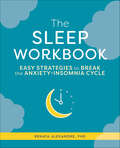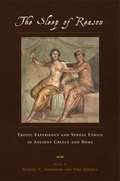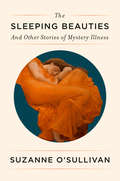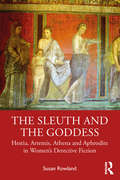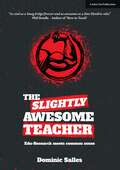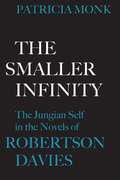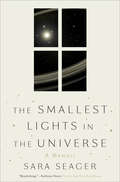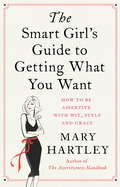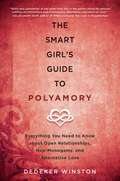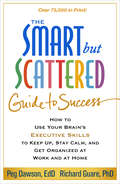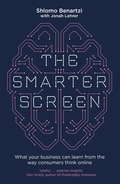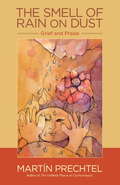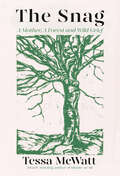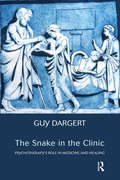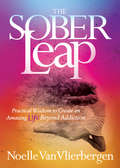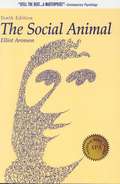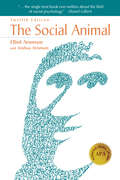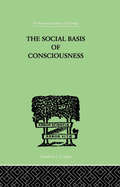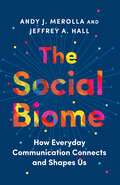- Table View
- List View
The Sleep Workbook: Easy Strategies to Break the Anxiety-Insomnia Cycle
by Renata AlexandreConquer anxiety-induced insomnia with your mind—a workbook for rethinking sleepIf you are among the 1/3 of adults in the United States dealing with the vicious cycle of chronic sleep disruption, you can put your worries to bed. The Sleep Workbook uses the scientifically proven Cognitive Behavioral Therapy for Insomnia (CBT-I) to change your thinking, improve your life, and help you get a good night's rest.By following easy-to-understand and easy-to-follow steps, you can reduce anxiety, change detrimental sleep habits, and sleep more easily. CBT-I can help you make measurable positive changes, boost your confidence, and have more energy to do the things that matter. Before turning to options like sleeping pills, take the time to understand your insomnia and change the things you have full control over—your thoughts and behavior.The Sleep Workbook contains:Personal experience—Use self-assessments, journal prompts, and self-reflective questions to fully grasp your underlying issues.Success rate—About 80% of people who complete CBT-I show long-term sleep improvement.A stronger you—As you learn to combat anxiety and other types of mood disorders, you'll likely increase your self-confidence because you were able to help yourself.No more counting sheep for you! Break the sleepless nights and start your days refreshed.
The Sleep of Reason: Erotic Experience and Sexual Ethics in Ancient Greece and Rome
by Martha C. Nussbaum Juha SihvolaSex is beyond reason, and yet we constantly reason about it. So, too, did the peoples of ancient Greece and Rome. But until recently there has been little discussion of their views on erotic experience and sexual ethics. The Sleep of Reason brings together an international group of philosophers, philologists, literary critics, and historians to consider two questions normally kept separate: how is erotic experience understood in classical texts of various kinds, and what ethical judgments and philosophical arguments are made about sex? From same-sex desire to conjugal love, and from Plato and Aristotle to the Roman Stoic Musonius Rufus, the contributors demonstrate the complexity and diversity of classical sexuality. They also show that the ethics of eros, in both Greece and Rome, shared a number of commonalities: a focus not only on self-mastery, but also on reciprocity; a concern among men not just for penetration and display of their power, but also for being gentle and kind, and for being loved for themselves; and that women and even younger men felt not only gratitude and acceptance, but also joy and sexual desire. Contributors: * Eva Cantarella * Kenneth Dover * Chris Faraone * Simon Goldhill * Stephen Halliwell * David M. Halperin * J. Samuel Houser * Maarit Kaimio * David Konstan * David Leitao * Martha C. Nussbaum * A. W. Price * Juha Sihvola
The Sleep of Reason: Erotic Experience and Sexual Ethics in Ancient Greece and Rome
by Martha C. Nussbaum Juha SihvolaSex is beyond reason, and yet we constantly reason about it. So, too, did the peoples of ancient Greece and Rome. But until recently there has been little discussion of their views on erotic experience and sexual ethics. The Sleep of Reason brings together an international group of philosophers, philologists, literary critics, and historians to consider two questions normally kept separate: how is erotic experience understood in classical texts of various kinds, and what ethical judgments and philosophical arguments are made about sex? From same-sex desire to conjugal love, and from Plato and Aristotle to the Roman Stoic Musonius Rufus, the contributors demonstrate the complexity and diversity of classical sexuality. They also show that the ethics of eros, in both Greece and Rome, shared a number of commonalities: a focus not only on self-mastery, but also on reciprocity; a concern among men not just for penetration and display of their power, but also for being gentle and kind, and for being loved for themselves; and that women and even younger men felt not only gratitude and acceptance, but also joy and sexual desire. Contributors: * Eva Cantarella * Kenneth Dover * Chris Faraone * Simon Goldhill * Stephen Halliwell * David M. Halperin * J. Samuel Houser * Maarit Kaimio * David Konstan * David Leitao * Martha C. Nussbaum * A. W. Price * Juha Sihvola
The Sleeping Beauties: And Other Stories of Mystery Illness
by Suzanne O'SullivanIn Sweden, hundreds of refugee children fall into a state that resembles sleep for months or years at a time. In Le Roy, a town in upstate New York, teenage girls develop involuntary twitches and seizures that spread like a contagion. In the U.S. Embassy in Cuba, employees experience headaches and memory loss after hearing strange noises during the night. These are only a few of the many suspected culture-bound psychosomatic syndromes—specific sets of symptoms that exist in a particular culture or environment—that affect people throughout the world. In The Sleeping Beauties, Dr. Suzanne O&’Sullivan—an award-winning Irish neurologist—investigates psychosomatic disorders, traveling the world to visit communities suffering from these so-called mystery illnesses. From a derelict post-Soviet mining town in Kazakhstan to the Mosquito Coast of Nicaragua to the heart of the María Mountains in Colombia, O&’Sullivan records the remarkable stories of syndromes related to her by people from all walks of life. Riveting and often distressing, these case studies are recounted with compassion and humanity. In examining the complexity of psychogenic illness, O&’Sullivan has written a book of both fascination and serious concern as these syndromes continue to proliferate around the globe.
The Sleuth and the Goddess: Hestia, Artemis, Athena and Aphrodite in Women’s Detective Fiction
by Susan RowlandRowland presents a detailed exploration of how the archetypes of ancient goddesses Hestia, Artemis, Athena and Aphrodite breathe into and shape female-authored detective fiction. Representing aspects of characterisation not bound by gender, the book examines how these archetypes emerge in themes like the home and hearth, hunting, survival and desire. Rowland assesses numerous examples from a range of works, providing a clear illustration of each archetype and illuminating aspects of femininity, psyche and being. This uniquely interdisciplinary work of literary analysis sheds light on the popularity and underlying mystique of the genre.
The Slightly Awesome Teacher: Edu-research Meets Common Sense
by Dominic SallesMost books on teaching ask teachers to be inspirational, to operate at 100 miles an hour with creativity oozing out of every pore. Dominic Salles says that's unsustainable. But you can get brilliant results using some simple practices taken from the myriad of educational research on classroom practices. It isn't a guide to all the extra stuff you should do to become cool and awesome. It is a book that will get you to forget about teaching and think about learning: another way of saying, it will help you to stop stressing about what you do, and get the students to work harder and smarter at what they do. Dominic Salles believes that every teacher can be slightly awesome. And here he shows you how.
The Slightly Awesome Teacher: Edu-research Meets Common Sense
by Dominic SallesMost books on teaching ask teachers to be inspirational, to operate at 100 miles an hour with creativity oozing out of every pore. Dominic Salles says that's unsustainable. But you can get brilliant results using some simple practices taken from the myriad of educational research on classroom practices. It isn't a guide to all the extra stuff you should do to become cool and awesome. It is a book that will get you to forget about teaching and think about learning: another way of saying, it will help you to stop stressing about what you do, and get the students to work harder and smarter at what they do. Dominic Salles believes that every teacher can be slightly awesome. And here he shows you how.
The Smaller Infinity: The Jungian Self in the Novels of Robertson Davies (The Royal Society of Canada Special Publications)
by Patricia MonkThe concepts of the Jungian theory of personality have long held considerable interest for Robertson Davies, both outside his fiction and as the explicit subject of The Manticore. This interpretive study discusses Davies' use of Jungian psychology as both a structural and a thematic device and touches on related themes of illusion and the nature of reality.Drawing extensively on early reviews and articles, Monk sketches the background to Davies' preoccupation with psychology, revealing its influence on his early writings, including the effect of the Jungian concept of the persona on Shakespeare's Boy Actors and the ocncept of the shadow on the Samuel Marchbanks material. She also notes the introduction of the important themes of illusion, as a mask for reality, and ambivalence which are extended in the Salterton trilogy, Fifth Business, and The Manticore. Monk concludes that World of Wonders reveals an apparent but unsuccessful attempt on Davies' part to get away from Jungian psychology, and an exploration of alternative myths of human identity: the romance myth of the hero and the Spenglerian myth of the Magian soul.
The Smallest Lights in the Universe: A Memoir
by Sara SeagerCanadian MIT astrophysicist Sara Seager interweaves the story of her search for meaning and solace after losing her first husband to cancer, her unflagging search for an Earth-like exoplanet and her unexpected discovery of new love.Sara Seager has made it her life's work to peer into the spaces around stars--looking for exoplanets outside our solar system, hoping to find the one-in-a-billion world enough like ours to sustain life. But with the unexpected death of her husband, her life became an empty, lightless space. Suddenly, she was the single mother of two young boys, a widow at forty, clinging to three crumpled pages of instructions her husband had written for things like grocery shopping--things he had done while she did pioneering work as a planetary scientist at MIT. She became painfully conscious of her Asperger's, which before losing her husband had felt more like background noise. She felt, for the first time, alone in the universe.In this probing, invigoratingly honest memoir, Seager tells the story of how, as she stumblingly navigated the world of grief, she also kept looking for other worlds. She continues to develop groundbreaking projects, such as the Starshade, a sunflower-shaped instrument that, when launched into space, unfurls itself so as to block planet-obscuring starlight, and she takes solace in the alien beauty of exoplanets. At the same time, she discovers what feels every bit as wondrous: other people, reaching out across the space of her grief. Among them are the Widows of Concord, a group of women offering consolation and advice, and her beloved sons, Max and Alex. Most unexpected of all, there is another kind of one-in-a-billion match with an amateur astronomer. Equally attuned to the wonders of deep space and human connection, The Smallest Lights in the Universe is its own light in the dark.
The Smallest Lights in the Universe: A Memoir
by Sara SeagerIn this luminous memoir, an MIT astrophysicist must reinvent herself in the wake of tragedy and discovers the power of connection on this planet, even as she searches our galaxy for another Earth.Sara Seager has always been in love with the stars: so many lights in the sky, so much possibility. Now a pioneering planetary scientist, she searches for exoplanets—especially that distant, elusive world that sustains life. But with the unexpected death of Seager&’s husband, the purpose of her own life becomes hard for her to see. Suddenly, at forty, she is a widow and the single mother of two young boys. For the first time, she feels alone in the universe.As she struggles to navigate her life after loss, Seager takes solace in the alien beauty of exoplanets and the technical challenges of exploration. At the same time, she discovers earthbound connections that feel every bit as wondrous, when strangers and loved ones alike reach out to her across the space of her grief. Among them are the Widows of Concord, a group of women offering advice on everything from home maintenance to dating, and her beloved sons, Max and Alex. Most unexpected of all, there is another kind of one-in-a-billion match, not in the stars but here at home.Probing and invigoratingly honest, The Smallest Lights in the Universe is its own kind of light in the dark.
The Smart Girl's Guide to Getting What You Want
by Mary HartleyDo you feel like you're not heard but you don't want to have to scream?Personal development coach Mary Hartley explains the secrets of assertiveness - of how to communicate with other people in ways that are confident, effective - but also considerate. Mary reveals the simple steps you can take to help you relate to other people honestly and openly in every area of your life - at work, with your friends and family and in your love life. You will discover that you can be true to yourself and your needs without hurting or diminishing other people. * What assertiveness is and why it matters * How to avoid aggression, passivity and manipulation * Tips for handling tricky situations including put-downs and dealing with bullies * Mastering assertive body language and communication Packed with practical strategies and exercises, this book will show you how to be confident, assured and proactive - with style.
The Smart Girl's Guide to Polyamory: Everything You Need to Know About Open Relationships, Non-Monogamy, and Alternative Love
by Dedeker WinstonNo one likes a know-it-all, but everyone loves a girl with brains and heart. The Smart Girl's Guide to Polyamory is an intelligent and comprehensive guide to polyamory, open relationships, and other forms of alternative love, offering relationship advice radically different from anything you'll find on the magazine rack.This practical guidebook will help women break free of the mold of traditional monogamy, without the constraints of jealousy, possessiveness, insecurity, and competition. The Smart Girl's Guide to Polyamory incorporates interviews and real-world advice from women of all ages in nontraditional relationships, as well as exercises for building self-awareness, confidence in communication, and strategies for managing and eliminating jealousy. If you're curious about exploring group sex, opening up your current monogamous relationship, or ready to "come out” as polyamorous, this book covers it all!Whether you're a seasoned graduate, a timid freshman, or somewhere in between, you'll learn how to discover and craft unique relationships that are healthy, happy, sexy, and tailor-made for you. Because when it comes to your love life, being a know-it-all is actually a great thing to be.
The Smart but Scattered Guide to Success: How to Use Your Brain's Executive Skills to Keep Up, Stay Calm, and Get Organized at Work and at Home
by Peg Dawson Richard GuareAre you smart, scattered, and struggling? You're not alone. Cutting-edge research shows that today's 24/7 wired world and the growing demands of work and family life may simply max out the part of the brain that manages complex tasks. That's especially true for those lacking strong executive skills/m-/the core brain-based abilities needed to maintain focus, meet deadlines, and stay cool under pressure. In this essential guide, leading experts Peg Dawson and Richard Guare help you map your own executive skills profile and take effective steps to boost your organizational skills, time management, emotional control, and nine other essential capacities. The book is packed with science-based strategies and concrete examples, plus downloadable practical tools for creating your own personalized action plan. Whether on the job or at home, you can get more done with less stress. See also the authors' Smart but Scattered parenting guides, plus an academic planner for students and related titles for professionals.
The Smarter Screen: What Your Business Can Learn from the Way Consumers Think Online
by Jonah Lehrer Shlomo Benartzi'A must-read for investors, business owners, and anyone else with a stake in how people make decisions in the digital age' Bill Harris, CEO of Personal Capital and former CEO of PayPalThe typical office worker now spends the majority of their waking hours staring at a screen. In the 21st century, every business is a digital business, which is why it's so critical to understand how we think and behave online.Acclaimed behavioural economist Shlomo Benartzi has teamed up with science writer Jonah Lehrer to reveal a toolkit of cues and nudges for the digital age. Using provocative case-studies and engaging reader exercises, Benartzi shows how businesses can update their nudges to help consumers make better decisions on screens. Up-to-the-minute research will help optimise your business's online presence, from designing a webshop that helps your customers find what they are looking for, to laying out your website so that it both attracts and holds attention.This book will help you transform the challenges of the digital world into powerful new opportunities that will drive your success.
The Smell of Rain on Dust
by Martín PrechtelInspiring hope, solace, and courage in living through our losses, author Martín Prechtel, trained in the Tzutujil Maya shamanic tradition, shares profound insights on the relationship between grief and praise in our culture--how the inability that many of us have to grieve and weep properly for the dead is deeply linked with the inability to give praise for living. In modern society, grief is something that we usually experience in private, alone, and without the support of a community. Yet, as Prechtel says, "Grief expressed out loud for someone we have lost, or a country or home we have lost, is in itself the greatest praise we could ever give them. Grief is praise, because it is the natural way love honors what it misses."Prechtel explains that the unexpressed grief prevalent in our society today is the reason for many of the social, cultural, and individual maladies that we are currently experiencing. According to Prechtel, "When you have two centuries of people who have not properly grieved the things that they have lost, the grief shows up as ghosts that inhabit their grandchildren." These "ghosts," he says, can also manifest as disease in the form of tumors, which the Maya refer to as "solidified tears," or in the form of behavioral issues and depression. He goes on to show how this collective, unexpressed energy is the long-held grief of our ancestors manifesting itself, and the work that can be done to liberate this energy so we can heal from the trauma of loss, war, and suffering.At base, this "little book," as the author calls it, can be seen as a companion of encouragement, a little extra light for those deep and noble parts in all of us.
The Snag: A Mother, A Forest, and Wild Grief
by Tessa McWattIn her memoir The Snag, the acclaimed, award-winning author of Shame on Me, Tessa McWatt, takes on personal and collective grief, and the solace and inspiration to be found in connecting with nature—and each other.Every day, we hear about and experience griefs, large and small, in our families, friendships, communities, and worldwide. The grief of a loved one passing. The grief of a way of life ceasing to exist. The grief of global pandemic, war, climate collapse.As her mother&’s dementia advances and she can no longer live independently, Tessa McWatt confronts personal and political losses, and finds herself wandering in a forest asking, how do we grieve? And what can we learn from nature and those whose communities are rooted in nature about not only how to grieve but also how to live?From the newest seedling to the oldest snag in the forest, there is meaning to be found in every stage of a tree&’s life, all of which contribute to a thriving forest community. In this forest thinking, Tessa begins to find answers to her questions about how to live (for each other), how to grieve (radically), and how to die (with love and connection).The Snag is an essential book about living and dancing and singing and praying, even in the face of unimaginable sadness, and in this way, growing together and supporting one another, like the trees in the forest.
The Snake in the Clinic: Psychotherapy's Role in Medicine and Healing
by Guy DargertThis book is for psychotherapists and would make a wise companion for anyone starting out in the profession. It entreats readers to be mindful of symptoms, how not to confuse symptoms with illness and how both can be read as paths to the deeper reaches of the psyche where the cause of illness lies.
The Sober Leap: Practical Wisdom to Create an Amazing Life Beyond Addiction
by Noelle Van VlierbergenThe Sober Leap helps recovering addicts take their recovery to the next level. Millions of women enter recovery from alcohol addiction with one goal in mind: to stay sober. They&’re left to their own devices to &“figure it out&” from there, leaving them feeling lost, disenchanted, and susceptible to relapse. The Sober Leap invites recovering addicts to step into the light and thrive in recovery. Certified Health and Addiction Recovery Coach Noelle Van Vlierbergen provides practical wisdom to change the habits and behaviors that are holding readers back from showing up fully as a powerful, sober woman. With honesty and humor, Noelle shares her own experiences with recovery and introduces readers to eleven basic principles that will transform the mind, body, and soul. Reintroducing readers to the truths they&’ve always known, but lost along the way, The Sober Leap is a call to action to let go of the past, embrace the present, and finally start living the life you were meant to live.
The Sober Life Journal: Finding Freedom One Day At A Time
by Simon ChappleThe Sober Life Journal is an all-new format that captures the essence of journaling and provides space to grow and develop as you embark on a sober life. With hundreds of writing prompts, pages for reflection, focus, inspiration and guided exercises, this beautiful new journal supports your intention to create something lasting and meaningful to accompany you on your journey to an alcohol-free life.Every day is a new fresh page, and this journal gives you the time, the tools and the safe space you need to take things one step at a time as you journey one day at a time towards a life full of joy and freedom.
The Sober Life Journal: Finding Freedom One Day At A Time
by Simon ChappleThe Sober Life Journal is an all-new format that captures the essence of journaling and provides space to grow and develop as you embark on a sober life. With hundreds of writing prompts, pages for reflection, focus, inspiration and guided exercises, this beautiful new journal supports your intention to create something lasting and meaningful to accompany you on your journey to an alcohol-free life.Every day is a new fresh page, and this journal gives you the time, the tools and the safe space you need to take things one step at a time as you journey one day at a time towards a life full of joy and freedom.
The Sober Truth
by Zachary Dodes Lance DodesAn exposé of Alcoholics Anonymous, 12-step programs, and the rehab industry--and how a failed addiction-treatment model came to dominate America. AA has become so infused in our society that it is practically synonymous with addiction recovery. Yet the evidence shows that AA has only a 5-10 percent success rate--hardly better than no treatment at all. Despite this, doctors, employers, and judges regularly refer addicted people to treatment programs and rehab facilities based on the 12-step model. In The Sober Truth, acclaimed addiction specialist Dr. Lance Dodes exposes the deeply flawed science that the 12-step industry has used to support its programs. Dr. Dodes analyzes dozens of studies to reveal a startling pattern of errors, misjudgments, and biases. He also pores over the research to highlight the best peer-reviewed studies available and discovers that they reach a grim consensus on the program's overall success. But The Sober Truth is more than a book about addiction. It is also a book about science and how and why AA and rehab became so popular, despite the discouraging data. Dr. Dodes explores the entire story of AA's rise, from its origins in early fundamentalist religious and mystical beliefs to its present-day place of privilege in politics and media. The Sober Truth includes true stories from Dr. Dodes's thirty-five years of clinical practice, as well as firsthand accounts submitted by addicts through an open invitation on the Psychology Today website. These stories vividly reveal the experience of walking the steps and attending some of the nation's most famous rehabilitation centers. The Sober Truth builds a powerful response to the monopoly of the 12-step program and explodes the myth that these programs offer an acceptable or universal solution to the deeply personal problem of addiction. This book offers new and actionable information for addicts, their families, and medical providers, and lays out better ways to understand addiction for those seeking a more effective and compassionate approach to this treatable problem. From the Hardcover edition.
The Social Animal (10th edition)
by Elliot Aronson Joshua AronsonThis book is a brief, compelling introduction to modern social psychology. Through vivid narrative, lively presentations of important research, and intriguing examples, Elliot Aronson probes the patterns and motives of human behavior, covering such diverse topics as terrorism, conformity, obedience, politics, race relations, advertising, war, interpersonal attraction, and the power of religious cults.
The Social Animal (A\series Of Books In Psychology)
by Elliot Aronson Joshua AronsonA landmark text that maintains its relevance and unique approach edition after edition, The Social Animal offers a brief, compelling introduction to modern social psychology. Through vivid narrative, lively presentations of important research, and intriguing examples, Elliot Aronson probes the patterns and motives of human behavior, covering such diverse topics as terrorism, conformity, obedience, politics, race relations, advertising, war, interpersonal attraction, and the power of religious cults.
The Social Basis Of Consciousness: A STUDY IN ORGANIC PSYCHOLOGY Based upon a Synthetic and Societal
by Burrow, TrigantFirst Published in 1999. Routledge is an imprint of Taylor & Francis, an informa company.
The Social Biome: How Everyday Communication Connects and Shapes Us
by Jeffrey A. Hall Andy J. MerollaA deep dive into the importance of daily communication and how we can harness its power to create a better life We spend much of our waking lives communicating with others. How does each moment of interaction shape not only our relationships but also our worldviews? And how can we create moments of connection that improve our health and well-being, particularly in a world in which people are feeling increasingly isolated? Drawing from their extensive research, Andy J. Merolla and Jeffrey A. Hall establish a new way to think about our relational life: as existing within &“social biomes&”—complex ecosystems of moments of interaction with others. Each interaction we have, no matter how unimportant or mundane it might seem, is a building block of our identities and beliefs. Consequently, the choices we make about how we interact and who we interact with—and whether we interact at all—matter more than we might know. Merolla and Hall offer a sympathetic, practical guide to our vital yet complicated social lives and propose realistic ways to embrace and enhance connection and hope.
